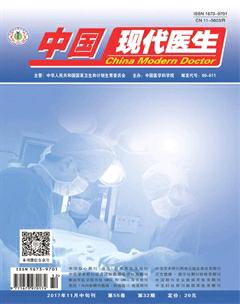糖尿病对心脏手术患者预后的影响
王媛媛++++++李元梅++++++李惠莉++++++应慧敏++++++田芳++++++周振锋
[摘要] 目的 回顧性评价糖尿病对体外循环(CPB)下心脏手术患者预后的影响。方法 回顾性收集我院于2012年1月~2015年12月CPB下心脏手术患者1554例。根据术前是否合并糖尿病分为糖尿病组和对照组。记录两组患者一般资料和术中资料。记录术后主要观察指标:术后肺部感染和其他感染率;次要观察指标包括院内死亡率和其他并发症。采用多因素回归统计分析。 结果 共1256例纳入研究分析。糖尿病与术后其他感染、切口愈合延迟及因出血二次手术的发生有关,而且糖尿病组术后机械通气时间和术后住院时间延长。本研究未发现糖尿病与院内死亡、肺部感染、术后新发房颤、脑梗死、连续性肾替代治疗、因切口愈合延迟二次手术和术后6个月内再入院率相关。 结论 糖尿病患者行CPB下心脏手术中只有5.3%达到 HBA1c≤7%。相比无糖尿病者,糖尿病患者术后因再出血二次手术、切口愈合不良和其他感染率增加,并且术后机械通气和住院时间延长。目前我国也尚无指南建议DM患者行心脏手术的最佳HBA1c值,需要更多研究证据。
[关键词] 糖尿病;心脏手术;感染;预后
[中图分类号] R587.1 [文献标识码] B [文章编号] 1673-9701(2017)32-0081-04
[Abstract] Objective To retrospectively evaluate the effect of diabetes mellitus on the prognosis of patients undergoing cardiac surgery under cardiopulmonary bypass(CPB). Methods A total of 1554 patients undergoing cardiac surgery under CPB in our hospital from January 2012 to December 2015 were retrospectively collected. According to whether to merge with the preoperative diabetes mellitus, the patients were divided into two groups including diabetes group and control group. The general information and intraoperative information of the patients were recorded. The main observed indicators after surgery including the rates of postoperative pulmonary infection and other infections and the secondary observed indicators including hospital mortality and other complications were recorded. Multivariate regression analysis was used. Results A total of 1256 patients were included in the study. Diabetes mellitus was related to postoperative other infections, incision healing delay and the occurrence of secondary surgery due to bleeding. And the postoperative mechanical ventilation time and postoperative hospital stay were prolonged in the diabetic group. The study did not find that diabetes mellitus was correlated with hospital death, pulmonary infection, postoperative new atrial fibrillation, cerebral infarction, continuous renal replacement therapy, secondary surgery due to delayed incision healing and re-admission rate within 6 months. Conclusions Only 5.3% of diabetic patients undergoing cardiac surgery under CPB had HBA1c≤7%. Compared with those of non-diabetic patients, the rates of secondary surgery due to rebleeding after surgery, poor incision healing and other infections increase. And the postoperative mechanical ventilation time and hospital stay are prolonged in the diabetic group, compared to those in non-diabetes. At present, there is no guideline in our country to suggest the optimal HBA1c value of cardiac surgery for DM patients, and more evidence is needed.endprint
[Key words] Diabetes mellitus; Heart surgery; Infection; Prognosis
糖尿病(diabetes mellitus DM)在世界范围內呈流行趋势。2010年调查显示我国成人糖尿病患病率为11.6%,糖尿病已成为我国重大的公共卫生问题[1]。糖尿病使心血管并发症增加了2~4倍[2],糖尿病相关并发症增加了手术机率,而且人数还在增加[3]。研究还证实合并糖尿病者手术预后更差[4]。
目前研究关注糖尿病对心脏术后长期预后及胰岛素治疗的影响,但大多数研究只关注冠状动脉旁路移植术(CABG),极少全面关注糖尿病对其他心脏手术预后的影响[5],更缺少糖尿病对心脏手术患者住院期间临床预后的影响[6]。因此,本研究调查国内糖尿病患者行心脏手术住院期间的临床预后,有助于了解并改善患者的预后。
1 资料与方法
1.1一般资料
获得本院伦理委员会批准后,回顾性收集2012年1月~2015年12月1554例体外循环(CPB)下行开胸心脏手术患者。排除标准:年龄< 18周岁、体外循环下不停跳手术、急诊手术或术中采用深低温技术、二次开胸手术、使用主动脉球囊反搏术、术中死亡、术后使用体外膜肺氧合装置、心脏移植手术或先天性心脏病矫治术等。按照术前是否合并糖尿病分为糖尿病组和对照组,一名内分泌科医生通过查阅病例确认糖尿病诊断。围术期维持血糖在6.7~11.1 mmol/L,术中使用短效胰岛素控制血糖。术后患者均带管送重症监护病房(ICU), 术后72 h常规连续心电监护。收集基础临床资料、术中资料和术后观察指标。
1.2观察指标
术后肺部感染诊断标准如下[7]:有发热或咳痰症状,且有实验室检查结果(痰培养阳性或胸片、CT影像学变化)。②其他感染包括颈内静脉感染、尿道感染、切口感染,诊断标准:体温≥ 38.5℃并有血液化验检查支持,有感染科医生会诊记录。所有病例由一名感染科医生通过查阅病例再确认。次要观察指标包括院内死亡率、因切口愈合延迟或出血二次手术、ICU天数、住院时间、术后6个月内再入院率和以下结局:①切口愈合延迟定义为术后第8天胸部切口未愈合;②新发房颤诊断诊断依据术后心电图或以下病史记录中至少两项[8]:病程记录、护理记录、出院小结和治疗药物改变,术前有房颤者不纳入术后新发房颤统计分析;③脑梗死诊断标准如下[9]:新发脑缺血症状≥ 24 h,并有脑部影像学证据;④术后连续肾脏透析治疗(CRRT):术前肾功能异常不纳入术后CRRT分析(包括血肌酐水平升高:男性 >1.6 mg/dL 或女性> 1.4 mg/dL)[10]。
1.3统计学分析
采用SAS 8.0软件进行统计分析,计量资料(x±s) 表示,组间均数比较采用t检验,计数资料采用χ2检验或Fisher精确检验。采用泊松多因素回归分析术后结局发生率在5%以内,5%以上采用Logistic多因素回归。采用线性回归分析机械通气时间、ICU时间及术后住院时间,纳入自变量参考院内死亡纳入因素。将单因素分析中组间比较P≤0.2的术前及术中变量纳入多因素回归分析,其他纳入因素根据既往文献报道[7-10]。P<0.05为差异有统计学意义。
2 结果
2.1一般资料
共有1256例纳入分析,糖尿病129例,见图1。男性占50.3%,平均年龄55岁,CABG手术178例(14.2%),主动脉瓣手术179例(14.3%),二尖瓣手术261例(20.8%),三尖瓣手术75例(6.0%),复合手术563例(44.8%)。糖尿病组患者平均糖尿病程8年,80%以上需要使用胰岛素,胰岛素日平均剂量为31U,平均血糖为7.5 mmol/L,平均糖化血红蛋白(HBA1c) 为9.3 g/dL,只有5.3%患者HBA1c≤7%。
2.2两组患者术前及术中资料比较
与对照组相比,糖尿病组患者年龄和体重指数较大,男性偏多,合并ASA Ⅲ和既往吸烟史者更多,合并高血压、高脂血症、慢性肾脏疾病、术前30 d内心肌梗死、贫血更常见,更多患者需要降压药和抗凝药物,术前基础血糖值较高和血红蛋白值偏低(P<0.05),见表1。糖尿病组麻醉、手术和体外循环时间均显著延长,行冠脉搭桥术者更多,但复合手术者较少,出血更多,术中需要输注更多血制品和液体量(P<0.05),见表2。
2.3两组患者术后资料比较
体外循环下心脏手术患者总院内死亡率为1.6%,糖尿病组为3.9%,而对照组为1.3%。术前合并糖尿病与术后其他感染、切口愈合延迟和因出血二次手术的发生有关,而且糖尿病组术后机械通气时间和术后住院时间延长。本研究未发现糖尿病与术后肺部感染、CRRT、因切口愈合延迟二次手术、新发房颤、脑梗死、ICU时间和术后6个月内再入院率相关,见表3、4。
3 讨论
本研究发现糖尿病不但会增加术后切口愈合延迟、其他感染和因出血二次手术率,还会延长术后机械通气时间和住院时间。糖尿病患者常合并冠心病、高血压等基础疾病,同时糖尿病会影响血管正常功能,促进血管内皮增生,减弱血管弹性,使糖尿病患者易于出血[11];高血糖时会降低一氧化氮活性,使超氧自由基等物质产生增加,从而损害血管内皮功能[12];高血糖和体外循环都会促进炎症反应,引起血管氧化应激反应,导致血管内血栓形成和斑块破裂,还会影响血小板正常功能[13]。这些因素均会增加术后因出血二次手术的发生。另外,高血糖还会影响单核细胞、中性粒细胞及内皮细胞功能,进而增加术后感染的风险[14]。
糖尿病对切口愈合的影响考虑以下几方面:①糖尿病可形成糖基化终末产物,从而诱导肿瘤坏死因子-α、白细胞介素-1等炎性因子的产生和阻碍胶原合成,最终影响伤口愈合[15];②糖尿病患者细胞趋化和吞噬作用、杀菌能力均降低,而且热休克蛋白也会减少,这些变化都与伤口愈合不良密切相关;③伤口愈合的一个重要过程就是血管新生形成肉芽组织,但糖尿病患者不但缺乏多种生长因子,而且血管新生功能也下降[16]。endprint
多项研究证实[17,18]糖尿病患者行CABG术后长期死亡率增高。目前关于糖尿病对CABG术后30 d内死亡率存在争议。研究发现,相比无糖尿病患者,糖尿病患者行CABG手术围术期死亡率明显增高[18,19];另一方面,Risum等[17]和Marcheix等[20]報道不管术前有无糖尿病,术后早期死亡率并无差异,其他研究认为DM不是住院期间死亡的独立预测因子[6]。本研究也未发现DM与住院期间死亡相关。这可能与死亡发生率低,而术后观察时间过短有关。
有研究认为糖尿病病程和治疗方式都不是患者生存率的主要决定因素[18]。有研究发现不管是否使用胰岛素治疗,CABG术后住院期间心肌梗死、脑梗死、住院时间和死亡率都无显著差异[19]。为了评估糖尿病对心脏手术的影响,本研究不区分糖尿病病程和治疗方式,将所有糖尿病患者作为整体一组进行分析。有研究发现当HBA1c≤7%时,CABG术后主要并发症和死亡率均下降[21],这要求我们针对DM患者不但需要密切关注术中血糖波动,而且更需平稳控制术前血糖。
综上所述,糖尿病患者行CPB下心脏手术中只有5.3%达到 HBA1c≤7%,术后因再出血二次手术、切口愈合延迟和其他感染率增加,并且术后机械通气和住院时间延长。目前我国也尚无指南建议DM患者行心脏手术的最佳HBA1c值,需要更多研究证据。
[参考文献]
[1] 徐瑜,毕宇芳,王卫庆,等. 中国成人糖尿病流行与控制现状——2010年中国慢病监测暨糖尿病专题调查报告解读[J]. 中华内分泌代谢杂志,2014,30(3):184-186.
[2] Stamler J,Vaccaro O,Neaton JD,et al. Diabetes,other risk factors,and 12-year cardiovascular mortality for men screened in the multiple risk factor intervention trial[J]. Diabetes Care, 1993,16(2):434-444.
[3] Frisch A,Chandra P, Smiley D, et al. Prevalence and clinical outcome of hyperglycemia in the perioperative period in noncardiac surgery[J]. Diabetes Care,2010,33(8): 1783-1788.
[4] Li Z,Amsterdam EA,Young JN,et al. Contemporary outcomes of coronary artery bypass grafting among patients with insulin-treated and non-insulin-treated diabetes[J]. Ann Thorac Surg,2015,100(6):2262-2269.
[5] Fu AZ,Sheehan J. Treatment intensification for patients with type 2 diabetes and poor glycemic control[J]. Diabetes Obes Metab,2016,18(9):892-898.
[6] Zhang H,Yuan X,Osnabrugge RL,et al. Influence of diabetes mellitus on long-term clinical and economic outcomes after coronary artery bypass grafting[J]. Ann Thorac Surg,2014,97(6):2073-2079.
[7] Mohri Y,Tonouchi H,Miki C,et al. Incidence and risk factors for hospital-acquired pneumonia after surgery for gastric cancer:Results of prospective surveillance[J]. World J Surg,2008,32(6):1045-1050.
[8] Klinger RY, Thunberg CA, White WD, et al. Intraoperative magnesium administration does not reduce postoperative atrial fibrillation after cardiac surgery[J]. Anesth Analg,2015,121(4):861-867.
[9] Min JJ,Nam K,Kim TK,et al. Relationship between early postoperative C-reactive protein elevation and long-term postoperative major adverse cardiovascular and cerebral events in patients undergoing off-pump coronary artery bypass graft surgery:A retrospective study[J]. Br J Anaesth,2014,113(3):391-401.
[10] Khwaja A. KDIGO clinical practice guidelines for acute kidney injury[J]. Nephron Clin Pract,2012,120(4):c179-184.endprint
[11] Guerci B,Bohme P,Kearney-Schwartz A,et al. Endothelial dysfunction and type 2 diabetes. Part 2:altered endothelial function and the effects of treatments in type 2 diabetes mellitus [J]. Diabetes Metab,2001,27(4 Pt 1):436-447.
[12] Guzik TJ,Mussa S,Gastaldi D,et al. Mechanisms of increased vascular superoxide production in human diabetes mellitus: Role of NAD(P)H oxidase and endothelial nitric oxide synthase[J]. Circulation,2002,105(14):1656-1662.
[13] Marfella R,Esposito K,Giunta R,et al. Circulating adhesion molecules in humans: Role of hyperglycemia and hyperinsulinemia[J]. Circulation,2000,101(19):2247-2251.
[14] Perner A,Nielsen SE,Rask-Madsen J. High glucose impairs superoxide production from isolated blood neutrophils[J]. Intensive Care Med,2003,29(4):642-645.
[15] Niu Y, Cao X, Song F, et al. Reduced dermis thickness and AGE accumulation in diabetic abdominal skin[J]. Int J Low Extrem Wounds,2012,11(3):224-230.
[16] 褚月頡, 王鹏华. 糖尿病伤口愈合不良的相关机制[J]. 国际内分泌代谢杂志, 2014, 34(2):131-134.
[17] Risum O,Abdelnoor M,Svennevig JL,et al. Diabetes mellitus and morbidity and mortality risks after coronary artery bypass surgery[J]. Scand J Thorac Cardiovasc Surg, 1996,30(2):71-75.
[18] Salomon NW,Page US,Okies JE,et al. Diabetes mellitus and coronary artery bypass short-term risk and long-term prognosis[J]. J Thorac Cardiovasc Surg,1983,85(2): 264-271.
[19] Cohen Y,Raz I,Merin G,et al. Comparison of factors associated with 30-day mortality after coronary artery bypass grafting in patients with versus without diabetes mellitus. israeli coronary artery bypass(ISCAB) study consortium[J]. Am J Cardiol,1998, 81(1):7-11.
[20] Marcheix B, Vanden EF, Demers P, et al. Influence of diabetes mellitus on long-term survival in systematic off-pump coronary artery bypass surgery[J]. Ann Thorac Surg,2008, 86(4):1181-1188.
[21] Santos JM,Favaloro RR,Lowenstein D, et al. Medium-term glycemic control in diabetics before coronary bypass surgery [J]. Medicina (B Aires), 2015, 75(5): 277-281.
(收稿日期:2017-03-08)endprint

